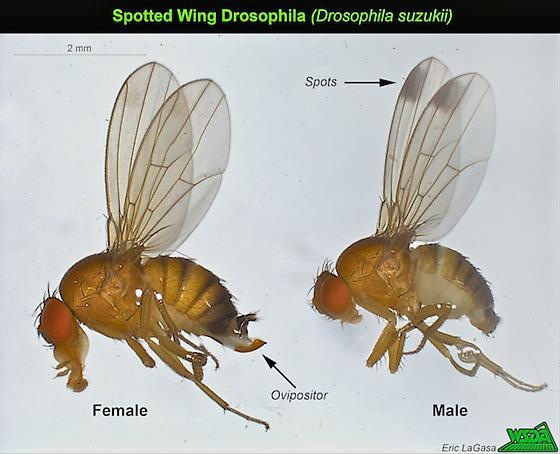Contact Us




WY CAPS Program
University of Wyoming
Dept. Ecosystem Science & Management: 3354
1000 East University Ave.
Laramie, WY 82071
Phone: (307)766-5278
Email: caps@uwyo.edu
WY Cooperative Agricultural Pest Survey
Featured Pests
Spotted Wing Drosophila Drosophila suzukii (Matsumura)
Spotted Wing Drosophila (SWD) Drosophila suzukii is an insect pest of economically valuable small fruit and tree fruit crops. Known to be in Fremont County, Wyoming since about 2011, this species now appears to be spreading across counties in Wyoming.
History of the SWD
The Spotted Wing Drosophila is a vinegar fly native to Southeast Asia. First found in the United States in Hawaii in the 1980's and then in California in 2008, it has since spread to many states including our neighboring states of Colorado, Utah, Idaho and Nebraska. In Wyoming, it has been found in Laramie, Fremont, Goshen and Platte counties.
What does the SWD look like?
Like other members of the vinegar fly family, D. suzukii is small, approximately 2 to 3.5 mm in length and 5 to 6 mm in wingspan and looks like its fruit and vinegar fly relatives. Its body is yellow to brown with darker bands on the abdomen and it has red eyes. The male has a distinct dark spot near the tip of each wing; females do not have the spotted wing. The female has a long, sharp, serrated ovipositor. The larvae are small, white and cylindrical, reaching 3.5 mm in length.
Why is the SWD considered a pest?
The SWD is a fruit crop pest and is a serious economic threat to soft summer fruits: cherries, blueberries, raspberries, strawberries, blackberries, peaches, nectarines, grapes and others. Unlike its vinegar fly relatives which are primarily attracted to rotting or fermented fruit, female SWD attack fresh ripe fruit by using their saw-like ovipositor to lay eggs under the fruit's soft skin. The larvae hatch and grow in the fruit, destroying the fruit's value. Once established in an orchard or garden, this insect is very hard to eradicate in the warm summer months.
What is the lifecycle of SWD?
Adults emerge from overwintering when temperatures reach approximately 50oF. The fertilized female searches for ripe fruit, lands on the fruit, inserts its serrated ovipositor to pierce the skin and deposits a clutch of 1 to 3 eggs per insertion. Females will oviposit on many fruits and in areas of scarce fruit, many females will oviposit on the same fruit. A female may lay up to 300 eggs during her life span.
The larvae grow inside the fruit. The oviposition site is visible in many fruit by a small pore scar in the skin of the fruit called a sting. After 1 to 2 days, the area around the sting softens and depresses creating an increasingly visible blemish. Larvae may leave the fruit or remain inside it to pupate. Several generations of SWD will hatch during a season but it has not been determined how many generations will hatch per season in Wyoming, and this would be temperature dependent.
Prevention
If you have a suspect soft fruit, slice it open and check for larvae (maggots). If the fruit is infected DO NOT put it into your compost pile, but rather place it in a baggie and freeze the fruit to kill the SWD larvae. Then dispose of the contaminated fruit.
Contact Us




WY CAPS Program
University of Wyoming
Dept. Ecosystem Science & Management: 3354
1000 East University Ave.
Laramie, WY 82071
Phone: (307)766-5278
Email: caps@uwyo.edu

